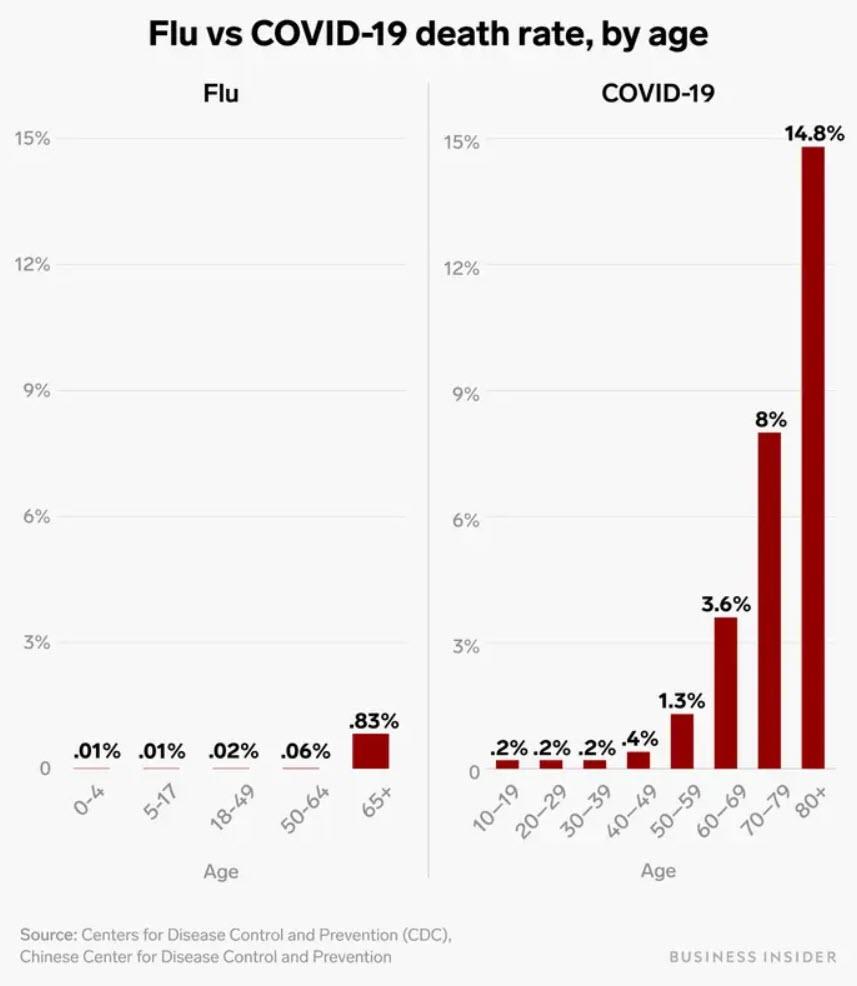Blue » Fri Mar 06, 2020 3:52 pm wrote:Gonna be a lot of very sick or dead elderly and compromised immune system Americans who have not been tested who will go on record as dying of the flu or pneumonia, or some other ailment. It's gonna be a cover up.
Completely agree, too many key actors have no incentive to tell the truth. Nobody wants to be
first to take measures that would reduce tourism or tax income, but it will all be inevitable pretty soon here. Even once the response gets coordinated and serious, though, most of the casualties will be written off on the margins, or -- like the death toll of the US opioid epidemic --
not investigated at all.
Been a hell of a week, as expected. Even with some beers, it's all a lot to take in.
Italy has gone Full Wuhan, and the EU response will be largely shaped by a desperate attempt to contain that from here. That attempt will be increasingly disrupted by the realization there are at least a half-dozen other epicenters going in their midst, especially France and Spain, and possibly even Germany, their economic engine and true ruler. (I also think all four of them may wind up dwarfed by the unknown unknowns of an outbreak in Greece, barely solvent, teetering, and over-run with already "immunocompromised" arab immigrants.)
There's going to be a lot of Reversion To Primary Loyalties in the EU, and that alliance as a whole will be scarred with too-obvious fault lines come 2021 -- and that's the best case scenario, where there's no COVID-20 Second Wave coming through to double the death toll. Said fault lines are already visible, too:
"EU fails to persuade France, Germany to lift coronavirus health gear controls," per Reuters. Shit like this is why I've never bought the diversity hype, we are who we are and we all have our people. The rest is just ad campaigns.
Speaking of ad campaigns, pity the PR workers who have to pivot next week from "there's nothing to worry about" to "nothing is under control." Per the Telegraph:
"Government is expected to announce there is no hope of stopping the spread of the virus." Per the nerd losers at Vox:
"Two or three weeks ago, we were still hoping for containment. We’re really past that. ... The horse is out of the barn." A mastery of folksy idiom is so crucial for a successful career these days.
Horses, out of barns:
In its situation report today, the WHO said that, over the last 24 hours, 17,481 cases, including 335 deaths, have been reported outside China from 88 countries.
Which bring me to the United States of America. I'm honestly surprised that the US response has been even worse than I expected -- my cynicism is a pretty decent baseline for real world predictions, but seldom does my guesswork look so naively optimistic in retrospect. I expected persistent systemic problems after the response got going, but I didn't expect there to be
essentially no response for six consecutive weeks. But here we are.
It is encouraging to see
big events --
SXSW,
comic book conventions -- getting cancelled. In the next week, we'll see a lot of news about outbreak clusters being traced to concerts (and, especially, political rallies) that should have been cancelled, but at least things are improving.
The problem is that things are improving too late to prevent the leading-edge, most-dangerous cascade effect of the nCoV outbreak, which is a wave of cases overwhelming the existing emergency care medical system.
The West Coast is fucked, well and truly. The whole corridor is seeded, has weeks of ongoing community spread, and seems poorly prepared to deal with it, in the face of their ongoing governance and infrastructure problems. Washington state is facing a critical shortage of masks already -- that's kind of a constant throughout the US, but the irony of this oversight transpiring in the backyard of Bill "Global Health" Gates is acute.
Both Italy and South Korea are solid indications of what we can expect from here: a hockey-stick chart of explosive growth in confirmed infections which is only constrained by the limitations on testing. (Just
posted some articles quantifying those limitations.)
As a selfish meme, I'm most troubled by the fact Vermontistan is now completely surrounded by confirmed cases, and has only executed 8 tests to date. Like most states, most countries, it's already here. NYC and Mass are both clusters that only seem small due to the lack of a serious response, and the week to come will only offer a glimpse at the true extent of their problems -- but it will become clear those problems are not "contained" in any sense.
It's not just self-interest, either. Vermont, like Maine, has a big elderly population. So does NY, CT and New Jerusalem. Then there's Pennsylvania and Mass, and a huge a streak down the center of the midwest through the Dakotas down to Arkansas. Stated bluntly, all of this is dry tinder, fuel for the fire.
And how much of a priority will it really be to run autopsies on bodies from long-term care facilities? Especially when you have to run two samples to verify and that pipeline is full of tests for people who are, currently, still alive?
This brings us back to Blue's point: most of this will just get written off without any attribution.
On the clinical front, there's a lot of creepy news. HK researchers, who have been sober and careful so far (and done a fucking outstanding job containing contagion among their health workers) are
currently pegging the CFR at 1.4% -- or, you know, 14x the fatality rate of "Just The Flu, Bro." More troubling is the indications that nCoV
does affect children, and may be doing so on a slower timetable than adults. This would imply that schools are basically amplifiers for super-spreaders, such a Satanically devious viral strategy that now I'm wondering about bioweapons, too.
One curious detail of the HK studies: the indictions that aerosol transmission might be less common than expected, per previous coronaviruses (and influenza itself), which would make the focus on keeping surfaces clean even more important.
The investigators also collected air samples from near the mouth of a patient with a moderate viral load. The virus was not detected in any test, and tests of objects in the room detected it only on a window bench, suggesting that environmental transmission may not be as important as person-to-person transmission
Yet that also makes it inevitable that public transportation would be an ongoing vector for infection. So again and again, we come to the same inevitability of marginalized workers and citizens bearing the brunt of social crises. This is not exactly a new song. Homeless victims? Won't be counted, won't matter. Victims in public housing? Won't be counted, won't matter. Time to move on as a nation.
A few green shoots: Newsom swears
testing will be free. Kudlow is proposing tax relief -- not for you, of course,
for "targeted" corporations. Yet even these limited initiatives will be, at worst, funded by strategic cuts to other threads of the social safety net -- or at best, through new bond issuances.
Most interventions will remain aimed at the "supply" side of the equation. The "demand" side will keep being neglected.
This reminded me of Vinay Gupta's early wiki work
on pandemic response, and sure enough, he's got some provocations up on Ycombinator:
Via: https://news.ycombinator.com/item?id=22489895A hashtag: #FLUSTARTUP
Come on, there's 8 weeks of fairly-contained virus before the hockey stick goes vertical. Long enough for companies to form or pivot. Key areas:
1) education for kids who will be out of school
2) cheap, low-cost respirators - can CPAP machines be adapted? what about vacuum cleaners - run one as a pressure source, pipes and valves, serve 5 patients. @lucasgonzalez
3) masks designed for prolonged use by entire populations.
https://theconversation.com/copper-is-g ... e-it-73103 CU adjustment tabs etc Copper is great at killing superbugs – so why don't hospitals use it? Lack of knowledge and perceived cost issues could be holding back the fight against the superbugs.
4) Apps to coordinate check-ins on elderly relatives - have somebody in quality flu-blocking gear look in on mom, make sure she has her meds etc. #PandemicPostmates.
https://en.wikipedia.org/wiki/Fureai_kippu if you want a currency aspect, it works in Japan
5) Everything remote work. Everything.
6) @Uber but what turns up is a Tesla in biodefense mode, with a driver who's taking his temperature four times a day with spare masks and hand sanitizer for passengers. Do this!
7) Same thing, but for grocery deliveries.

Expect supply chain problems. Sharing app for items?
9) Parents are possibly exposed. You need eldercare. You need to get the kids out of the house. Helpers who are immune to flu because they've had it once are ideal for these roles. A "survivor work register" could be really key to lots of jobs.
10) Who's quick-training nurses to do a lot of flu-related stuff that used to need doctors? Who's training former-patients to do a lot of stuff that used to be done by nurses? The longer this goes on, the more probably-immune survivors you have to work in these critical roles.
(Copper is great a killing superbugs but it's also expensive. There is also no shortage of existing corporations in the remote working space.)
WHO is responding obliquely with a R&D roadmap of their own:
https://www.who.int/blueprint/priority- ... avirus/en/And how much of that will matter? Infections double every six days. Are you going to get testing done in six days?
Infections double again in twelve days. Are you going to make pitches and fast track financing by then?
Eighteen days later, infections have doubled again. Now you've got to work out manufacturing and distribution.
Before infections double again, six days after that.
And all that? All that's not even a month.
None of what I've posted here in this thread has been prognostication or prediction or inside information, just napkin math, sad and implacable. None of this ends well, anywhere, for anyone.
In closing, having wasted a lot of time reading up on existing policy and statutes, it's fucking pathetic how ad hoc the whole domestic response has been. These bitches don't even read their own boilerplate copy. Window dressing.
Kayfabe.




